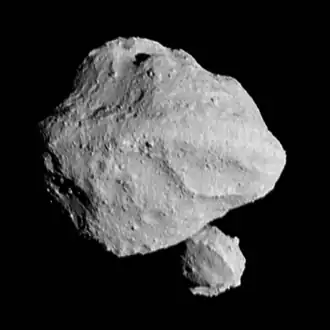2020 MK53
| Discovery[1] | |
|---|---|
| Discovered by | New Horizons KBO Search-Subaru |
| Discovery site | Mauna Kea Obs. |
| Discovery date | 22 June 2020 |
| Designations | |
| 2020 MK53 | |
| TNO[2] · distant[1] | |
| Orbital characteristics[2] | |
| Epoch 24 June 2020 (JD 2459024.5) | |
| Uncertainty parameter 9 | |
| Observation arc | 3 days |
| Aphelion | 160±30235 AU |
| Perihelion | 63±58812 AU |
| 111±21051 AU | |
| Eccentricity | 0.44±457 |
| 1174±33309 yr | |
| 182°±3376000° | |
| 0° 0m 3.024s / day | |
| Inclination | 182°±3376000° |
| 116°±2975° | |
| 351°±1470600° | |
| Physical characteristics | |
| 600–500 km (est. 0.1–0.2)[3] | |
| 26.3[4] | |
| 4.12±0.35[2][1] | |
2020 MK53 is a lost trans-Neptunian object discovered on 22 June 2020 and announced on 7 April 2023 (MPS 1836391, MPO 735634) by the New Horizons KBO Search team[5] using the 8.2-meter Subaru Telescope at Mauna Kea Observatory in Hawaii.[1] The orbit of 2020 MK53 is highly uncertain because it was observed for only 3 days, which is not long enough to determine an orbit accurately.[6][1] Its distance from the Sun might be around 160 astronomical units according to orbital calculations, which would make 2020 MK53 the farthest known Solar System object from the Sun.[7] However, the uncertainty in 2020 MK53's distance from the Sun ranges from ±4 AU to over ±20,000 AU, depending on the method of calculation.[6] Given its very short observation arc, the only reliably known property of 2020 MK53 is its extremely faint apparent magnitude of 26.3.[4]
References
- ^ a b c d e "2020 MK53". Minor Planet Center. International Astronomical Union. Retrieved 9 September 2023.
- ^ a b c "JPL Small-Body Database Browser: (2020 MK53)" (2020-06-25 last obs.). Jet Propulsion Laboratory. Retrieved 9 September 2023.
- ^ "Asteroid Size Estimator". Center for Near Earth Object Studies. Jet Propulsion Laboratory. Retrieved 31 May 2022.
- ^ a b "Distant objects". Minor Planet Center. International Astronomical Union. Retrieved 10 September 2023.
- ^ "Subaru Telescope and New Horizons Explore the Outer Solar System". Subaru Telescope. Retrieved 10 September 2023.
- ^ a b C. de la Fuente Marcos & R. de la Fuente Marcos (1 January 2024). "Past the outer rim, into the unknown: structures beyond the Kuiper Cliff". Monthly Notices of the Royal Astronomical Society Letters. 527 (1): L110 – L114. arXiv:2309.03885. Bibcode:2024MNRAS.527L.110D. doi:10.1093/mnrasl/slad132. Retrieved 28 September 2023.
- ^ "JPL Horizons On-Line Ephemeris for 2020 MK53". JPL Horizons On-Line Ephemeris System. Jet Propulsion Laboratory. Retrieved 9 September 2023. Ephemeris Type: VECTORS, Target Body: Asteroid (2020 MK53)
External links
- 2020 MK53 at AstDyS-2, Asteroids—Dynamic Site
- 2020 MK53 at the JPL Small-Body Database
.png)

_(cropped).jpg)
